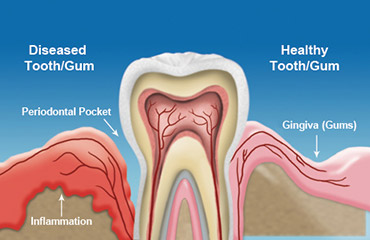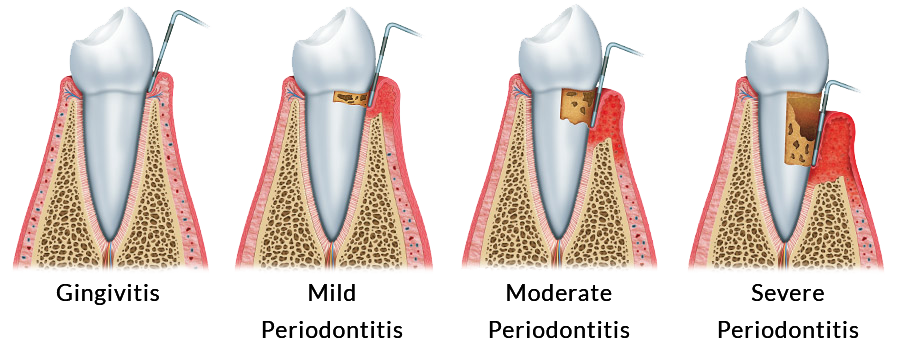About Gum Disease

- How Gum Disease Progresses
- Levels of Gum Disease
- Symptoms of Gum Disease
- Other Health Issues Linked to Gum Disease
- Contributing Factors of Gum Disease
- Complimentary Exam and Consultation
What is Gum Disease?
 Gum disease is also known as periodontal disease, from peri “around” and odont “tooth.” It is a continuous and progressive bacterial infection and inflammation in the gums and bone surrounding your teeth. If left untreated, inflammation causes your gums to gradually detach from your teeth, which allows even more bacteria to invade the gums and bone tissue. Eventually, your teeth can become loose or may even be lost.
Gum disease is also known as periodontal disease, from peri “around” and odont “tooth.” It is a continuous and progressive bacterial infection and inflammation in the gums and bone surrounding your teeth. If left untreated, inflammation causes your gums to gradually detach from your teeth, which allows even more bacteria to invade the gums and bone tissue. Eventually, your teeth can become loose or may even be lost.
Gum disease is a “quiet” disease, one that often produces no pain or discomfort until it has become severe. It is the leading cause of tooth loss in adults in the United States. Gum disease has been linked to serious overall health problems such as diabetes, cardiovascular disease, osteoporosis and certain cancers. It is therefore vital to detect and treat it as early as possible.
Expert gum disease treatment
Dr. Levine is a highly trained specialist in the prevention, diagnosis and effective treatment of gum disease. He will eliminate the bacterial deposits that cause the disease and restore your oral health, even if your gum disease has progressed to an advanced stage. In many cases, Dr. Levine can reverse the damage that was done, through periodontal procedures that restore lost gum and bone.
How Gum Disease Progresses
 When your jawbone and gum tissues are healthy, the gums and connective tissues, known as periodontal ligaments, are attached firmly to your teeth. There is full bone support and your teeth are held stably in position. Healthy gums are pink, firm and do not bleed easily. The gums naturally attach to the teeth just below the visible gum line.
When your jawbone and gum tissues are healthy, the gums and connective tissues, known as periodontal ligaments, are attached firmly to your teeth. There is full bone support and your teeth are held stably in position. Healthy gums are pink, firm and do not bleed easily. The gums naturally attach to the teeth just below the visible gum line.
Bacteria from food and other sources can get onto your teeth and below your gumline. If these bacteria are not regularly removed through brushing and flossing, they form a sticky biofilm on your teeth, called plaque. As plaque builds up, it hardens into calculus, or tartar.
Calculus deposits irritate the gums, and the body’s immune system starts fighting the bacterial infection by causing inflammation. When the immune response is excessive, irritation and inflammation cause the gums to gradually withdraw and detach from the teeth. More aggressive bacteria are then able to lodge under your gumline, emitting toxins that erode your teeth, gums and bone. As the bacterial infection progresses in size and severity, gum detachment and bone loss become more advanced. Teeth eventually become loose or even fall out.
Levels of Gum Disease
There are two main levels of gum disease as it progresses from mild to severe:
Gingivitis
The first level of gum disease is called gingivitis. Gingivitis is a condition that affects the gums only. It is characterized by inflamed, swollen, red gums that may bleed when you brush or floss. At this stage, the gums have not started to detach from the teeth, and the infection can usually be eliminated through thorough professional dental cleaning and effective home oral care.
Periodontitis
The second level of gum disease, known as periodontitis, is more severe and progresses in stages. At this point the infection has started to cause the gums to detach from the teeth, forming open spaces between the teeth and gums, known as pockets. The infection also starts to reach deep enough to contact the supporting bone and begin eating it away.
As periodontitis progresses, continued detachment of the gums provides greater and deeper surface area for more bacteria to accumulate. More aggressive strains of bacteria will lodge in the pockets and the rate of gum detachment and bone loss increases and accelerates.
Dr. Levine evaluates the level of gum disease, in part, by gently measuring the depths of your gum pockets with a small probe. He notes any gum recession, checks for loose teeth, and examines your X-rays to determine the extent of bone loss around your teeth.

Mild periodontitis—There is gum inflammation and the pockets are between 3 mm and 4 mm in depth. There is some gum detachment, some beginning bone loss and possibly some gum recession.
Moderate periodontitis—The pocket depths are between 4 mm and 6 mm. More significant bone loss has occurred around the teeth, and more advanced gum recession could be present.
Severe periodontitis—The gum pockets are now 6 mm or deeper and bone loss has become severe. Teeth may have become loose or shifted in position, resulting in an uncomfortable bite. Often, gum recession has occurred at this stage. There may be no bleeding and no pain, but the teeth are compromised and in danger of being lost, as tooth roots are only 10 to 12 mm long.
Symptoms of Gum Disease
The following are symptoms of gum disease. If you are experiencing any of the these symptoms, you should see Dr. Levine for a comprehensive examination to find out if you have gum disease, and if so, how far it has progressed and what treatment is needed.
- Tender or bleeding gums
- Red or swollen gums
- Bad breath that persists and won’t go away
- Gums that have receded or teeth that appear longer than normal
- Teeth that have shifted position
- Loose teeth
- Painful chewing
- An abscess below your gumline
Contributing Factors of Gum Disease
Although bacterial infection and its effects are the most immediate causes of gum disease, there are many contributing factors that can cause the infection and inflammation to take hold much easier and progress at greater speed:
- Genetic predisposition—An estimated 50 percent of the population is genetically predisposed to gum disease. Effective home oral care and regular professional cleanings can keep the disease in check or prevent it from occurring.
- Inadequate home oral care—Improper or infrequent brushing and flossing fails to remove sufficient bacteria, allowing the formation of plaque and eventual calculus below the gumline. This ends up causing gum detachment and progressive bone loss.
- Inadequate frequency of dental cleanings—Even the best home oral care can miss some of the bacteria buried below your gumline. Regular dental cleanings will keep these cleaned up and prevent infection from taking root.
- Poor nutrition—A poor diet, deficient in essential nutrients, can cause chronic health problems that make you more susceptible to gum disease.
- Smoking—Smoking and tobacco products inhibit blood flow to the gums and lower the tissues’ ability to fight off infection or heal. Additionally, studies have revealed that the bacterial strains that most aggressively damage gum tissue are found in smokers’ mouths.
- Systemic health problems—Cardiovascular disease, respiratory disease, diabetes and various autoimmune disorders can contribute to gum disease by lessening the body’s resistance to infection.
- Treatments for other health problems—Certain medical treatments weaken the gums or cause excess gum tissue growth, which makes your mouth harder to clean. Additionally, certain medications inhibit the production of saliva. Saliva has a protective effect in your mouth, and inadequate saliva flow leaves your gums more susceptible to infection.
- Hormonal changes—Hormonal changes can cause the gums to become more sensitive, increasing susceptibility to infection and inflammation.
- Earlier mistakes in dental treatment—Poorly fitting crowns or bridges can leave gaps where bacteria accumulate and cause infection.
Other Health Issues Linked to Gum Disease
Since gum disease is a bacterial infection, the bacteria can enter the bloodstream and cause difficulties in other parts of the body. Inflammation can spread and cause complications far away from its point of origin. Studies have shown significant links between gum disease and serious health problems such as respiratory disease, cardiovascular disease, certain cancers, diabetes and strokes. It is therefore important to detect and effectively treat gum disease as early as possible.
Come and See Us For a Complimentary Exam and Consultation
If you suspect that you have gum disease or are concerned that past treatment has not gotten your gum disease under control, come and see us for a Complimentary New Patient Exam. The doctor will determine the extent of your gum disease, explain your treatment options and answer all your questions.
To make an appointment, call 954‑722‑1100 or click here to request an appointment online.
